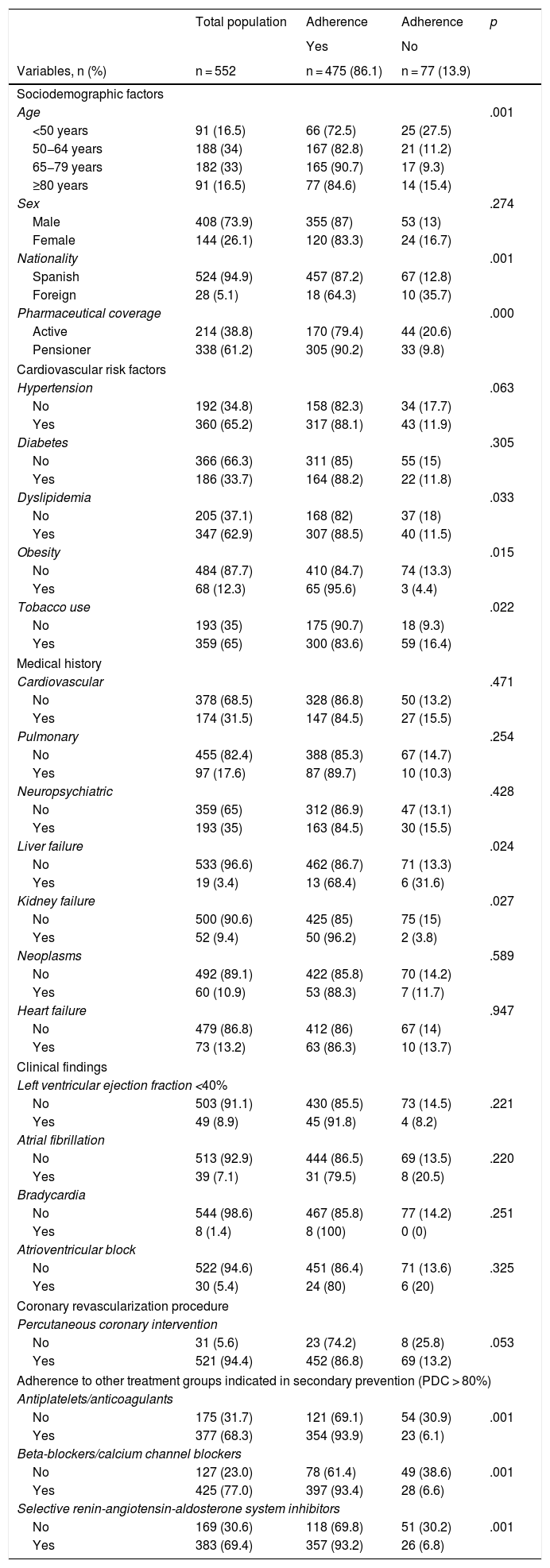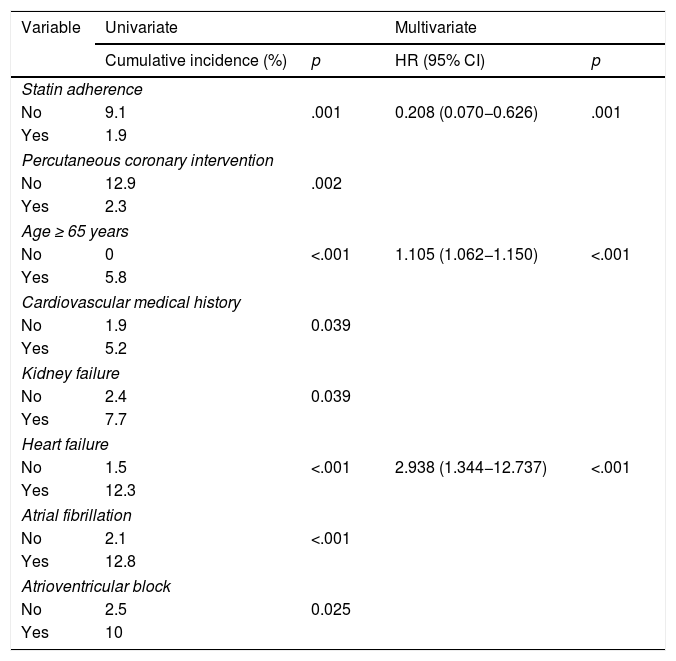There is deficient control of dyslipidaemia after ST-elevation myocardial infarction (STEMI) despite high rates of statin prescription. The aim of this study was to estimate the rate of statin treatment adherence after a first type 1 STEMI episode, the factors that determine the adherence and its impact on cardiovascular outcomes during the first year of progression.
DesignWe conducted an observational retrospective study with a cohort of patients hospitalised between 2008 and 2013, with an active statin prescription during the first year of follow-up.
Material and methodsWe determined the adherence using the proportion of days covered. The relationship between compliance and the rest of the variables was determined with a binary logistic regression analysis. Competing risk analysis assessed the relationship between cardiovascular mortality or new vascular event with adherence.
ResultsThe study included 552 patients (64.7 ± 13.7; 73.9% men) of the 613 analysed. There was less adherence among foreign nationals, smokers and individuals with hepatic impairment. Compliance was greater starting at 50 years of age, among pensioners and those with dyslipidaemia, obesity and kidney failure and in cases of compliance with the rest of the groups indicated in secondary prevention. Compliance reduced cardiovascular mortality (1.9% vs. 9.1%; HR 0.201; 95% CI 0.075−0.539; p = .001) but not the onset of a new cardiovascular event (5.5% vs. 6.5%; p = .834).
ConclusionsStatin adherence during the first year after a STEMI is a key factor in mortality, a period in which its assessment is needed beyond the prescription.
Existe un control deficiente de la dislipemia tras un infarto agudo de miocardio con elevación del segmento ST (IAMCEST) pese a una tasa de prescripción de estatinas elevada. El objetivo es estimar, tras un primer episodio de IAMCEST tipo 1, la tasa de adherencia a estatinas, los factores que la condicionan y su impacto en la morbimortalidad cardiovascular durante el primer año de evolución.
DiseñoEstudio observacional y retrospectivo en una cohorte de pacientes ingresados entre 2008 y 2013, con una prescripción de estatina activa durante el primer año de seguimiento.
Material y métodoDeterminación de la adherencia mediante la proporción de días cubiertos. Relación entre la adherencia con el resto de variables mediante el análisis de regresión logística binaria, y con la morbimortalidad cardiovascular a través del análisis de incidencia acumulativa.
ResultadosSe incluyeron 552 pacientes (64,7 ± 13,7 años, 73,9% hombres) de los 613 analizados. Existió una menor adherencia en caso de nacionalidad extranjera, tabaquismo o insuficiencia hepática; fue mayor a partir de 50 años, en los pensionistas, en la dislipemia, obesidad, insuficiencia renal y en caso de adherencia al resto de grupos indicados en prevención secundaria. La adherencia redujo la mortalidad cardiovascular, 1,9% frente a 9,1% (HR = 0,201; IC 95%, 0,075-0,539; p = 0,001), pero no la aparición de un nuevo evento cardiovascular, 5,5% frente a 6,5% (p = 0,834).
ConclusionesLa adherencia a estatinas durante el primer año tras un IAMCEST es un factor clave en la mortalidad, período en el que es necesaria su evaluación más allá de la prescripción.
Article
Diríjase desde aquí a la web de la >>>FESEMI<<< e inicie sesión mediante el formulario que se encuentra en la barra superior, pulsando sobre el candado.

Una vez autentificado, en la misma web de FESEMI, en el menú superior, elija la opción deseada.

>>>FESEMI<<<











